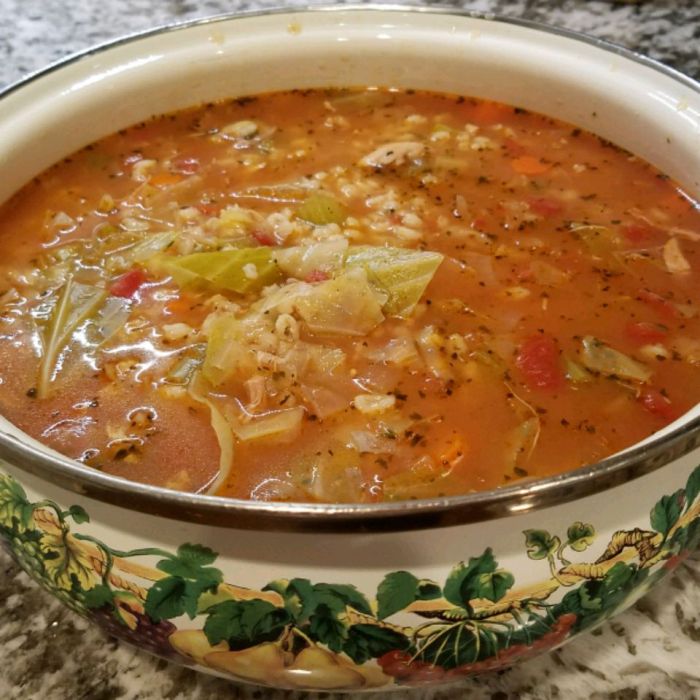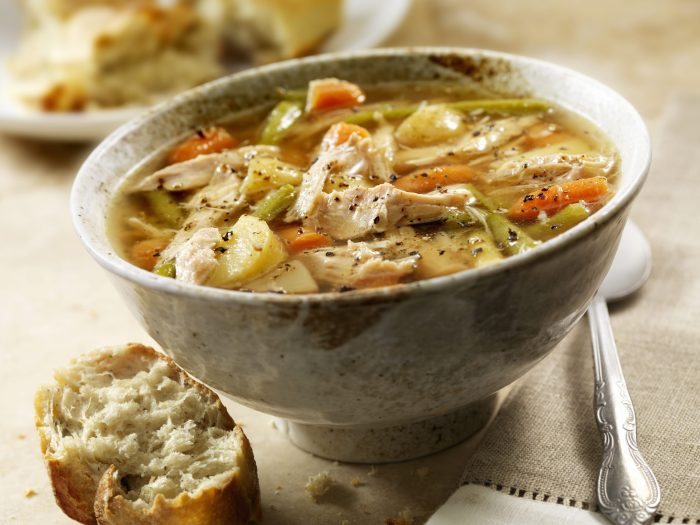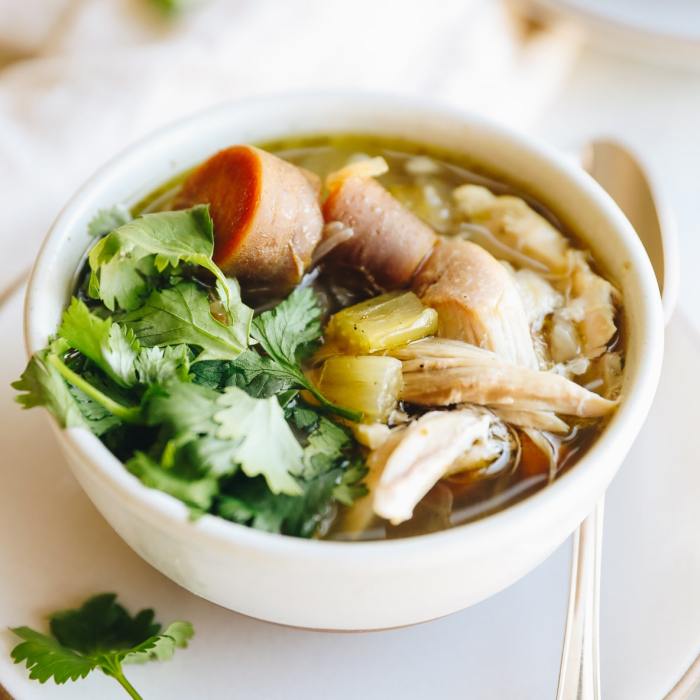Understanding the Turkey Carcass
Turkey soup carcass recipe – Utilizing a turkey carcass effectively for soup requires understanding its various components and their contribution to the final product. The nutritional value of the resulting broth also depends on the preparation and the type of turkey used. Different turkey breeds offer subtle variations in flavor and texture.
Turkey Carcass Components and Suitability for Soup

Source: allrecipes.com
A turkey carcass comprises the bones, skin, connective tissues, and residual meat. The bones contribute to the richness and depth of flavor in the broth, releasing collagen and minerals during simmering. The skin adds body and richness, while the connective tissues break down into gelatin, thickening the soup. Any remaining meat on the carcass provides additional flavor and protein.
Dark meat, often found on the legs and thighs, imparts a deeper, more savory flavor compared to the lighter breast meat.
Nutritional Value of Turkey Carcass Broth, Turkey soup carcass recipe
Turkey carcass broth is a nutrient-rich liquid. It’s a good source of gelatin, which supports gut health and joint function. It also contains minerals like calcium, phosphorus, and magnesium leached from the bones during simmering. The broth is low in fat, especially if excess fat is skimmed off during preparation. The nutritional content can vary slightly depending on the type of turkey and the ingredients added to the broth.
Flavor Variations Based on Turkey Type

Source: fanpage.it
Heritage turkeys, known for their slower growth and richer flavor, tend to yield a more intense and complex broth compared to commercially raised broad-breasted turkeys. Broad-breasted turkeys, while often larger, may produce a broth that is slightly less flavorful, although still nutritious. The skin of heritage turkeys is often thicker, contributing to a richer mouthfeel in the finished soup.
Preparing the Carcass for Soup
Proper cleaning and preparation of the turkey carcass are crucial for maximizing flavor and ensuring a safe and delicious soup. Browning the bones enhances the depth of flavor in the broth. Removing excess fat reduces the overall fat content of the final product.
Cleaning and Preparing the Turkey Carcass
Begin by removing any remaining meat from the carcass, reserving it for later use. Rinse the carcass thoroughly under cold water. Remove any large pieces of excess fat visible on the skin. This initial cleaning step prevents excessive greasiness in the final soup.
| Tool | Description | Use | Alternative |
|---|---|---|---|
| Large Stockpot | A large pot for simmering the broth. | Holding the broth during cooking | Large pot or Dutch oven |
| Chef’s Knife | For removing excess fat and meat. | Trimming and cutting | Sharp paring knife |
| Colander | For rinsing the carcass. | Rinsing and draining | Fine-mesh sieve |
| Wooden Spoon | For stirring the broth during simmering. | Stirring | Heat-resistant spatula |
Tips for Removing Excess Fat and Maximizing Flavor
To remove excess fat, carefully skim off any fat that rises to the surface during the initial simmering. Browning the carcass bones in a hot oven or on the stovetop before adding liquid helps to develop a deeper, richer flavor. This Maillard reaction creates complex flavor compounds that enhance the overall taste of the soup.
Importance of Browning the Carcass Bones
Browning the bones before simmering is a key step in developing a flavorful broth. This process, known as caramelization, creates a rich depth of flavor through the Maillard reaction. The browning intensifies the natural sweetness of the bones and adds a savory complexity to the final soup. It’s a crucial step for achieving a truly flavorful turkey carcass soup.
Building the Soup Base
Simmering the turkey carcass with appropriate vegetables and aromatics creates a rich and flavorful broth. The choice of vegetables significantly impacts the final taste and nutritional profile of the soup. Aromatic vegetables alone can produce a clear, delicate broth, ideal for those preferring a lighter soup.
Simmering Techniques for Rich Broth
Simmering the carcass gently in water for several hours allows the bones to release their collagen and minerals, creating a rich and flavorful broth. Adding a splash of vinegar or lemon juice can help extract more minerals from the bones. Maintaining a gentle simmer, rather than a rolling boil, prevents the broth from becoming cloudy and preserves its delicate flavor.
Common Vegetables in Turkey Carcass Soup
- Celery: Adds a subtle sweetness and earthy aroma.
- Carrots: Contributes sweetness and a vibrant color.
- Onions: Provides a base layer of savory flavor.
- Garlic: Adds pungency and depth of flavor.
- Leeks: Offer a milder onion flavor with a delicate sweetness.
- Parsnips: Contribute a subtly sweet and earthy note.
Clear Broth Recipe Variation (Aromatic Vegetables Only)
For a clear broth, use only aromatic vegetables like onions, carrots, celery, and leeks. Avoid root vegetables that might cloud the broth. Simmer gently for at least 3 hours, skimming off any foam that rises to the surface. Strain the broth carefully through a fine-mesh sieve to remove all solids, resulting in a crystal-clear, flavorful base.
Adding Flavor and Texture
The addition of herbs, spices, grains, and additional protein sources enhances both the flavor and texture of the turkey carcass soup. Careful selection and incorporation of these elements can significantly impact the overall culinary experience.
Herbs and Spices in Turkey Soup
Bay leaves provide a subtle herbal note, while thyme offers a slightly more pungent and earthy aroma. Rosemary adds a woodsy, slightly piney flavor. Sage contributes a warm, slightly peppery taste. Black pepper and salt are essential for seasoning, balancing the other flavors. Experimentation with different herb and spice combinations can create unique flavor profiles.
Incorporating Noodles, Rice, or Grains
Noodles, rice, or other grains can be added to the soup during the last 15-20 minutes of cooking, allowing them to cook thoroughly while absorbing the flavors of the broth. Choose grains that complement the overall flavor profile of the soup; for example, small pasta shapes work well, while wild rice adds a nutty flavor and chewy texture.
Adding Additional Protein Sources
Shredded leftover turkey meat from the original bird can be added back into the soup for extra protein and richness. Homemade dumplings, or even store-bought options, can be added during the last 10-15 minutes of cooking to add a satisfying textural element. Consider adding other proteins like shredded chicken or even meatballs for variety.
Serving and Storage
Proper serving and storage techniques ensure the longevity and quality of the turkey carcass soup. Creative repurposing of leftovers extends its culinary versatility.
Serving Suggestions
Serve the soup hot, garnished with fresh herbs like parsley or chives, a dollop of sour cream or crème fraîche, and a sprinkle of freshly cracked black pepper. Accompaniments like crusty bread or a side salad complement the soup perfectly. Consider serving it in rustic bowls for an enhanced presentation.
Storage Methods
| Storage Method | Duration | Quality Impact | Notes |
|---|---|---|---|
| Refrigerator | 3-4 days | Minimal impact if stored properly in an airtight container | Allow to cool completely before refrigerating |
| Freezer | 2-3 months | Slight texture change possible after thawing, but flavor remains good. | Freeze in airtight containers, leaving some headspace for expansion. |
Repurposing Leftover Soup
Leftover turkey soup can be used as a base for other dishes. It can be thickened and served as a hearty stew, or used as a sauce for pasta or polenta. It can also be incorporated into casseroles or used as a base for a creamy soup by blending it with cream or milk.
Recipe Variations and Adaptations: Turkey Soup Carcass Recipe
Adapting the basic recipe to suit various dietary needs and preferences opens up a world of culinary possibilities. Regional influences can also inspire unique flavor combinations.
Dietary Adaptations

Source: thehealthymaven.com
For a low-sodium version, reduce or omit added salt and use low-sodium broth. For a gluten-free version, ensure that any added noodles or dumplings are gluten-free. For a vegetarian adaptation, omit the turkey carcass and use vegetable broth as a base. Consider adding hearty vegetables and legumes for protein.
Regional Recipe Variations
- Mexican-inspired: Add chili powder, cumin, and corn. Garnish with cilantro and lime wedges.
- Asian-inspired: Incorporate ginger, soy sauce, and mushrooms. Garnish with green onions and sesame seeds.
- Italian-inspired: Add Italian herbs, such as oregano and basil, and finish with a drizzle of olive oil and grated Parmesan cheese.
Visual Description of a Perfectly Prepared Soup
A perfectly prepared turkey carcass soup boasts a rich, amber-colored broth, subtly translucent with a gentle shimmer. The aroma is deeply savory, with hints of herbs and spices mingling with the sweetness of the vegetables. The texture is comforting and hearty, with tender vegetables and perfectly cooked grains adding textural contrast to the smooth broth. The overall impression is one of warmth, depth, and satisfying nourishment.
User Queries
Can I freeze the turkey carcass before making soup?
Yes, freezing the carcass is perfectly acceptable. Ensure it’s properly wrapped to prevent freezer burn.
How long can I store leftover turkey soup?
Leftover soup can be stored in the refrigerator for up to 4 days or in the freezer for up to 3 months.
What if my broth is too salty?
Add more vegetables or water to dilute the saltiness. You can also add a potato to absorb some of the salt.
Can I use a different type of poultry carcass?
Yes, chicken or other poultry carcasses can be used, adjusting cooking time accordingly.
